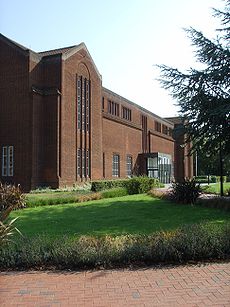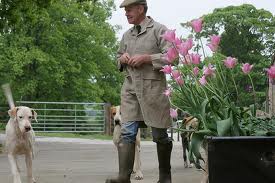From the
Times Telescope, an annual almanac, here is the entry for March, 1826, with a few quite optimistic pictures:
March, though the hours of promise with bright ray
May gild thy noons, yet, on wild pinion borne,
Loud winds more often rudely wake thy morn,
And harshly hymn they early-closing day.
The cutting blasts of March, so trying to the invalid, are equally injurious to the progress of vegetation; and the ‘sweet flowers’ are compelled to await the smiles and tears of gentle April to encourage their growth, and to bring them to perfection. Some more bold than the rest, who dare to brave the warrior front of Boreas, often perish in his chilly embrace. The winds of March, however, are highly beneficial to drying up the superabundant moisture of the earth; and although they may retard the delights and beauties of Spring, these are rendered more valuable to us, because they are less fugacious.
The russet-brown dress of the hedges is now spotted with green, preparatory to their assuming the complete vesture of Spring.—The leaves of the lilac begin to peep from beneath their winter clothing, and gooseberry and currant trees display their verdant foliage and pretty green blossoms. The yew-tree, ‘faithful in death,’ as it protects our tombs from the gaze of every passing stranger, when our more gaudy floral acquaintances have deserted us, opens its blossoms about the beginning of this month.

The melody of birds now gradually swells upon the ear. The throstle, second only to the nightingale in song, charms us with the sweetness, and variety of its lays. The linnet and goldfinch join the general concert in this month, and the golden-crowned wren begins its song. The lark also, must not be forgotten.—While the birds delight us with their song, the bees read us a lesson of industry, for they are to be seen collecting materials for their elegant condiment of honey on every fine day throughout the year.
Goldfinch
Each succeeding week pours forth fresh beauties from the lap of Flora, and furnishes the botanist with new sources of delight. Golden tufts of crocuses, expending their corollas to receive the genial warmth of the sun, interspersed with pink and blue hepaticas, and the garden daisy, with its little tufts of crimson velvet, united with the blossoms of last month, greatly ornament our flower borders. The alpine wall-cress is still in bloom; the mezereon puts forth its leaves; and the primrose peeps from the retreating snows of winter: it forms a happy shade of distinction between the delicate snowdrop and the flaming crocus.
Daffodils, yellow auriculas, coltsfoot, with its brilliant golden and sometimes pink or silvery stars, and hounds-tongue, are in blossom about the middle of the month. The American cowslip, with its beautiful rose-coloured blossoms, growing in thick branches in the form of a cone, flowers in March. The charming violet, whose attractions have been the theme of many a poetic effusion, makes her appearance this month, but not in full perfection, for the chill winds of March are not very congenial to the expansion of so delicate a blossom.
If the weather be mild, the rich hyacinth, the noble descendant of the modest harebell—the sweet narcissus, delicately pale, and some of the early tulips, are now in bloom. The peach and the nectarine begin to show their elegant blossoms.
Protected from inclemency of the weather by our green-houses, roses, hyacinths, heliotropes, and geraniums, are now in full blossom, regaling the senses with their varied hues and rich perfumes.
In this month, black ants are observed; the black-bird and the turkey law; the house pigeons sit. The greenfinch sings; the bat is seen flitting about; and the viper uncoils itself from its winter sleep. The wheatear, or English ortolan (Sylvia oenanthe) again pays its annual visit, leaving England in September. Those birds which have passed the winter in England now take their departure for more northerly regions; as the fieldfare, the red-wing, and the wood-cock.
On the 20th, the vernal equinox takes place, and all nature feels her renovating sway, and seems to rejoice at the retreat of winter.
The general or great flow of sap in most trees takes place in this month; this is preparatory to the expanding of the leaves and ceases when they are out. The ash now puts forth its grey buds; and the hazel and willow exhibit some signs of returning life in their silky, enfolding catkins. The leaves of the thornless rose and of the hawthorn are gradually becoming determinate. The field daisy is now seen scattered over dry pastures. This pretty flower, the poet’s darling, from Chaucer to Wordsworth and Montgomery, has claimed for itself many an elegant tribute.
The planting and sowing of Forest Trees is generally concluded in this month. The mixing of fir-trees with oaks (except in very sheltered situations) is now frequently adopted by the planter.
In March, trouts begin to rise, and blood worms appear in the water. The clay hair worms is found at the bottom of the drains and ditches, and the water-flea may be seen gliding about upon the surface of sheltered pools. Bats now issue from their places of concealment. Peas appear above ground; the sea-kale (Crambe maritima) begins to sprout. The male blossoms of the yew-tree expand and discharge their farina. Sparrows are busily employed in forming their nests. Young otters are produced, and young lambs are yeaned this month.
The equinoctial gales are usually most felt, both by sea and land, about this time.
The brimstone-coloured butterfly (Gonepteryx rhamni) which lives throughout the winter, is usually seen in March. It is found in the neighbourhood woods, on fine and warm days, enjoying the beams of the noonday sun. Some of our most beautiful butterflies, belonging to the genus Vanessa, as V. atalanta, Io, Polylcholoros, and Urticae, are seen in this month; and the Antiopa, or Camberwell beauty, has once been captured at this season.


























